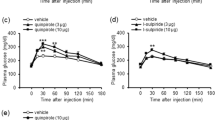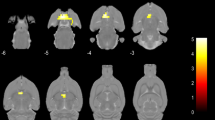Abstract
A LARGE portion of the central catecholaminergic nerve terminals of the rat are destroyed by administering 6-hydroxydopamine (6-HDA) via the cerebrospinal fluid1–3. Animals lesioned in this way often appear normal, yet show many subtle behavioural abnormalities4. We have been examining one example of this phenomenon, the failure of 6-HDA-lesioned rats to increase food intake when given a systemic injection of 2-deoxy-D-glucose (2-DG) (refs 5, 6). This glucose analogue seems to elicit feeding in intact rats due to its inhibition of glycolysis in cerebral chemoreceptor cells7,8. We have proposed9 that lesioned animals do not eat because of an insufficient central catecholaminergic response to the severe decrease in glucose utilisation induced by 2-DG (ref. 10). If so, then pretreatments which serve to augment this neurochemical response might be expected to reinstate behavioural function. Consistent with this hypothesis, very large increases in telencephalic tyrosine hydroxylase activity in 6-HDA-lesioned animals, which occur following chronic insulin treatment, are associated with the restoration of 2-DG-induced feeding11. Many of the physiological effects of catecholamines in the sympathetic nervous system seem to be mediated by an increase in the cyclic AMP concentration of the target cells. Methylxanthenes, such as caffeine and theophylline, inhibit phosphodiesterase, prevent cyclic AMP degradation, and thereby potentiate the catecholamine-stimulated rise in cyclic nucleotide12,13. They also enhance many of the behavioural and physiological effects of catecholamines12–15, presumably by the same mechanism. We therefore sought to determine whether the acute administration of those sympathomimetic agents, in intact and 6-HDA-lesioned rats, also would potentiate 2-DG-induced feeding, a behaviour that seems to be mediated, in part, by central catecholaminergic neurons. We report that caffeine restores the 2-DG-induced feeding response.
This is a preview of subscription content, access via your institution
Access options
Subscribe to this journal
Receive 51 print issues and online access
$199.00 per year
only $3.90 per issue
Buy this article
- Purchase on Springer Link
- Instant access to full article PDF
Prices may be subject to local taxes which are calculated during checkout
Similar content being viewed by others
References
Bloom, F. E., Algeri, S., Groppetti, A., Revuelta, A. & Costa, E. Science 166, 1284–1286 (1969).
Breese, G. R. & Traylor, T. D. J. Pharmac. exp. Ther. 174, 413–420 (1970).
Uretsky, N. J. & Iversen, L. L. J. Neurochem. 17, 269–278 (1970).
Stricker, E. M. & Zigmond, M. J. in Prog. Psychobiol. physiol. Psychol. 6, 121–188 (1976).
Zigmond, M. J. & Stricker, E. M. Science 177, 1211–1214 (1972).
Stricker, E. M. & Zigmond, M. J. J. comp. Physiol. Psychol. 86, 973–994 (1974).
Smith, G. P. & Epstein, A. N., Am. J. Physiol. 217, 1083–1087 (1969).
Stricker, E. M. & Rowland, N. J. comp. Physiol. Psychol. (in the press).
Stricker, E. M., Friedman, M. I. & Zigmond, M. J. Science 189, 895–897 (1975).
Meldrum, B. S. & Horton, R. W., Electroenceph. clin. Neurophysiol. 35, 59–66 (1973).
Zigmond, M. J., Volz, C. D., Stricker, E. M. & Friedman, M. I. Neurosci. Abstr. 2, 842 (1976).
Robison, G. A., Butcher, F. R. W. & Sutherland, E. W. Cyclic AMP (Academic, New York, 1971).
Greengard, P. Nature 260, 101–108 (1976).
Strömberg, U. & Waldeck, B. J. Pharm. Pharmac. 25, 302–308 (1973).
Fuxe, K. & Ungerstedt, U. Med. Biol. 52, 48–54 (1974).
Müller, E. E., Cocchi, D. & Mantegazza, P. Am. J. Physiol. 223, 945–950 (1972).
Waldeck, B. J. Pharm. Pharmac. 23, 824–830 (1971).
Teitelbaum, P. & Wolgin, D. L. Prog. Brain Res. 42, 235–249 (1975).
Ljungberg, T. & Ungerstedt, U. Physiol. Behav. 16, 277–283 (1976).
Oswald, I. Pharmac. Rev. 20, 273–303 (1968).
Stroufe, L. A. & Stewart, M. A. New Engl. J. Med. 289, 407–413 (1973).
Garfinkel, B. D., Webster, C. D. & Sloman, L., Am. J. Psychiat. 132, 723–728 (1975).
Wender, P. H. Life Sci. 14, 1605–1621 (1974).
Shaywitz, B. A., Yager, R. D. & Klopper, J. H. Science 191, 305–308 (1976).
Author information
Authors and Affiliations
Rights and permissions
About this article
Cite this article
STRICKER, E., ZIMMERMAN, M., FRIEDMAN, M. et al. Caffeine restores feeding response to 2-deoxy-D-glucose in 6-hydroxydopamine-treated rats. Nature 267, 174–175 (1977). https://doi.org/10.1038/267174a0
Received:
Accepted:
Issue Date:
DOI: https://doi.org/10.1038/267174a0
This article is cited by
-
Dopamine and reward: The anhedonia hypothesis 30 years on
Neurotoxicity Research (2008)
Comments
By submitting a comment you agree to abide by our Terms and Community Guidelines. If you find something abusive or that does not comply with our terms or guidelines please flag it as inappropriate.



